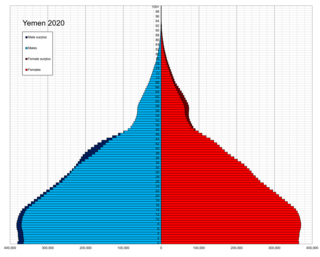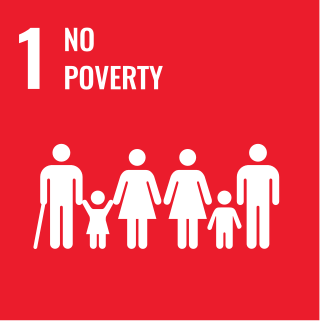
Extreme poverty is the most severe type of poverty, defined by the United Nations (UN) as "a condition characterized by severe deprivation of basic human needs, including food, safe drinking water, sanitation facilities, health, shelter, education and information. It depends not only on income but also on access to services". Historically, other definitions have been proposed within the United Nations.

The economy of Guatemala is a considered a developing economy, highly dependent on agriculture, particularly on traditional crops such as coffee, sugar, and bananas. Guatemala's GDP per capita is roughly one-third of Brazil's. The Guatemalan economy is the largest in Central America. It grew 3.3 percent on average from 2015 to 2018. However, Guatemala remains one of the poorest countries in Latin America and the Caribbean, having highly unequal incomes and chronically malnourished children. The country is beset by political insecurity, and lacks skilled workers and infrastructure. It depends on remittances for nearly one-tenth of the GDP.

Demographic features of the population of Yemen include population density, ethnicity, education level, health of the populace, economic status, religious affiliations and other aspects of the population.

Poverty is a state or condition in which one lacks the financial resources and essentials for a certain standard of living. Poverty can have diverse social, economic, and political causes and effects. When evaluating poverty in statistics or economics there are two main measures: absolute poverty compares income against the amount needed to meet basic personal needs, such as food, clothing, and shelter; relative poverty measures when a person cannot meet a minimum level of living standards, compared to others in the same time and place. The definition of relative poverty varies from one country to another, or from one society to another.

Poverty in India remains a major challenge despite overall reductions in the last several decades as its economy grows. According to an International Monetary Fund paper, extreme poverty, defined by the World Bank as living on US$1.9 or less in purchasing power parity (PPP) terms, in India was as low as 0.8% in 2019, and the country managed to keep it at that level in 2020 despite the unprecedented COVID-19 outbreak. According to World Bank, extreme poverty has reduced by 12.3% between 2011 and 2019 from 22.5% in 2011 to 10.2% in 2019. A working paper of the bank said rural poverty declined from 26.3% in 2011 to 11.6% in 2019. The decline in urban areas was from 14.2% to 6.3% in the same period.The poverty level in rural and urban areas went down by 14.7 and 7.9 percentage points, respectively. According to United Nations Development Programme administrator Achim Steiner, India lifted 271 million people out of extreme poverty in a 10-year time period from 2005–2006 to 2015–2016. A 2020 study from the World Economic Forum found "Some 220 million Indians sustained on an expenditure level of less than Rs 32 / day—the poverty line for rural India—by the last headcount of the poor in India in 2013."
Bangladesh is a developing nation. Despite rapid economic growth, poverty remains a major issue. However, poverty has declined sharply in recent history. Shortly after its independence, approximately 90% of the population lived under the poverty line. However, since economic reforms and trade liberalization of early 1990s, along with accelerated economic growth since early-2000s, Bangladesh have experienced a dramatic progress in reducing poverty. The remarkable progress in poverty alleviation has been recognized by international institutions. According to World Bank, more than 33 million Bangladeshi people have been lifted out of poverty since 2000; as measured by the percentage of people living on the equivalent of US$1.90 or less per day in 2011 purchasing price parity terms.

In 2021, official government statistics reported that the Philippines had a poverty rate of 18.1%,, significantly lower than the 49.2 percent recorded in 1985 through years of government poverty reduction efforts. From 2018 to 2021, an estimated 2.3 million Filipinos fell into poverty amid the economic recession caused by the COVID-19 pandemic.
The world's poor are significantly more likely to have or incur a disability within their lifetime compared to more financially privileged populations. The rate of disability within impoverished nations is notably higher than that found in more developed countries. Since the early 2010s there has been growing research in support of an association between disability and poverty and of a cycle by which poverty and disability are mutually reinforcing. Physical, cognitive, mental, emotional, sensory, or developmental impairments independently or in tandem with one another may increase one's likelihood of becoming impoverished, while living in poverty may increase one's potential of having or acquiring disability in some capacity.
Poverty in Niger is widespread and enduring in one of the world's most impoverished countries. In 2015, the United Nations (UN) Human Development Index ranked Niger as the second least-developed of 188 countries. Additionally, in 2015 the Global Finance Magazine ranked Niger 7th among the twenty-three poorest countries in the world. Two out of three residents live below the poverty line and more than 40 percent of the population earn less than $1 a day. Civil war, terror, illness, disease, poverty and hunger plague Niger. Hunger is one of the most significant problems the population faces daily. With a national population of 19,899,120, 45.7% of this population live below the poverty line.
Kenya is a lower-middle income economy. Although Kenya's economy is the largest and most developed in eastern and Central Africa, 16.1% (2023/2024) of its population lives below the international poverty line. This severe poverty is mainly caused by economic inequality, government corruption and health problems. In turn, poverty also worsens these factors. The Kenyan government's efforts to address poverty have received help from international institutions as well. The incident rate of poverty has steadily decreased, as shown by a recent MPI index.

Sustainable Development Goal 1, one of the 17 Sustainable Development Goals established by the United Nations in 2015, calls for the end of poverty in all forms. The official wording is: "No Poverty". Member countries have pledged to "Leave No One Behind": underlying the goal is a "powerful commitment to leave no one behind and to reach those farthest behind first".






